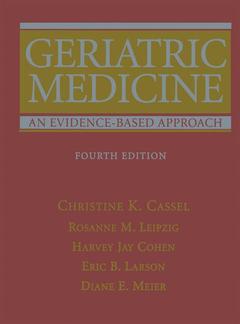Description
Geriatric Medicine (4th Ed., 4th ed. 2003. Softcover reprint of the original 4th ed. 2003)
An Evidence-Based Approach
Coordinators: Cassel Christine K., Leipzig Rosanne, Cohen Harvey Jay, Larson Eric B., Meier Diane E.
Language: English
Keywords
aging; assessment; care; frailty; geriatrics; gerontology; hospital; management; medicine; nursing; pharmacology; physiology; prevention; rehabilitation; sexuality
Geriatric Medicine (4th Ed.)
Publication date: 04-2013
1318 p. · 21x27.9 cm · Paperback
Publication date: 04-2013
1318 p. · 21x27.9 cm · Paperback
Geriatric medicine (4th Ed.)
Publication date: 01-2003
1318 p. · 21.6x27.9 cm · Hardback
Publication date: 01-2003
1318 p. · 21.6x27.9 cm · Hardback
Description
/li>Contents
/li>
Since the publication of the third edition of Geriatric Medicine,extraordinary advances have occurred in the science of aging and the potential for biomedical research to give us answers to many, if not most, of the age-related disorders that threaten the quality of life in older years. At the most basic level, the successful mapping of the human genome was declared complete in the fall of 2000. Understanding the map of the human genome is as important as understanding the map of genomes of important laboratory species, ranging from the microscopic worms and fruit?ies used in most classic genetic studies to rodents such as laboratory mice, and eventually to primates, on which much of the research on the aging human brain is done. The genetic maps of all of these species,including our own,does not answer clinical questions,but it does open the door to dramatic, rapid, and ef?cient answers to questions about the genetic polymorphisms related to diseases in humans. The telomerase story also unfolded since the third edition. Telomerase is an enzyme responsible for maintaining the telomeres?the redundant DNA portions at the end of chromosomes?whose shortening seems to be linked directly to cell senescence,ap- tosis,and the control over cell death,which,at the level of the individual cell,seems to be linked to the decline of organ function and eventually aging and death within the org- ism.
86 Chapters Total: PART I: BASICS OF GERONTOLOGY 1) Evidence-Based Medicine and Geriatrics 2) Molecular & Biologic Factors in Aging 3) Physiology of Aging 4) The Demography in Aging 5) Epidemiology & Aging 6) Psychosocial Influences on Health in Later Life 7) Principles of Pharmacology 8) Clinical Strategies of Prescribing for Older Adults PART II: CHANGING CONTEXTS OF CARE IN GERIATRIC MEDICINE 9) Contexts of Care 10) The Long and The Short of Long-Term Care 11) The Geriatrician in the Nursing Home 12) Home Care 13) Acute Hospital Care PART III: CLINICAL APPROACHES TO THE GERIATRIC PATIENT 14) Clinical Approach to the Older Patient: An Overview 15) Chronic Disease Management 16) Prevention 17) Instruments to Assess Funcational Status 18) Comprehensive Geriatric Assessment & Systems Approaches to Geriatric Care 19) Neurophysiological Testing 20) Preoperative Assessment & Perioperative Care 21) Anesthesia for the Geriatric Patient 22) Surgical Approaches to the Geriatric Patient 23) Rehabilitation PART IV: PALLIATIVE CARE 24) Old Age and Care Near the End of Life 27) Sources of Suffering in the Elderly 28) Acute & Chronic Pain 29) Palliative Care in Early, Moderate, and Advanced Dementia 30) The Value of Achieving a Peaceful Death PART V: MEDICAL CARE, SUBSECTION A: CANCER IN THE ELDERLY, Cancer in the Elderly: An Overview 31) The Science of Neoplasia and Its Relationship to Aging 32) Screening for Cancer 33) Breast Cancer 34) Colon Cancer & Other Gastrointestinal Malignancies 35) Lung Cancer 36) Prostate Cancer 37) Gynecologic Cancers 38) Hematologic Malignancies SUBSECTION B: ORGAN SYSTEM DISEASES & DISORDERS 39) Cardiovascular Disease 40) Hypertension 41) Peripheral Arterial Disease 42) Rheumatologic Diseases 43) Skeletal Fragility in the Elderly 44) Orthopedic Problems with Aging 45) Medical Aspects of Hip Fracture Management 46) Treatment of Diabetes 47) Thyroid Disorders 48) Changes in Male Sexuality 49) Sexual Function in the Older Woman 50) Gynecologic & Urologic Problems of Older Women 51) Benign Prostatic Hyperplasia 52) Nephrology/Fluid & Electrolyte Disorders 53) Immunology of Aging 54) Infectious Diseases 55) Hematologic Problems 56) Gastroenterologic Disorders 57) Pulmonary Disease 58) Dermatologic Diseases & Problems 59) Changes & Diseases of the Aging Eye 60) Otologic Changes & Disorders 61) Aging & the Oral Cavity SUBSECTION C: COMMON PROBLEMS IN OLDER ADULTS 62) Nutritional Supplements 63) Urinary Incontinence 64) Syncope 65) Pressure Ulcers, Wound Healing, etc 66) Falls 67) Chronic Dizziness & Vertigo 68) Nutrition 69) Exercise 70) Sleep & Sleep Disorders 71) Herpes Zoster 72) Elder Mistreatment 73) Frailty... PLUS 15 MORE CHAPTERS
© 2024 LAVOISIER S.A.S.




